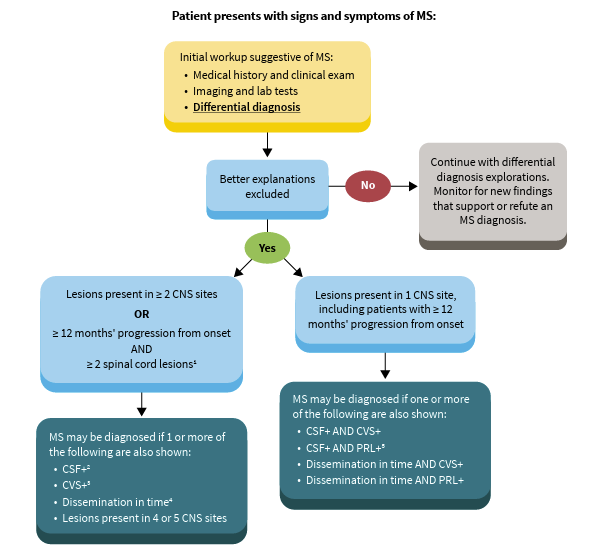
For people living with multiple sclerosis, early and accurate diagnosis is critical. It helps patients begin treatment sooner, manage symptoms more effectively, and improve long-term outcomes. On September 17th, The Lancet Neurology published a major update to the official guidelines used worldwide to diagnose MS, known as the McDonald Criteria. These new 2024 revisions were updated by the International Advisory Committee on Clinical Trials in Multiple Sclerosis and reflect nearly a decade of progress in MS research, imaging, and laboratory science.
Why the Update Was Needed

The National MS Society has developed this illustration of the new diagnostic process. Click to view the full image.
MS can be challenging to diagnose because no single test can confirm it. Neurologists rely on a combination of clinical history, neurological exams, MRI scans, and spinal fluid testing. Over time, diagnostic criteria have evolved to make sure patients are identified as early as possible, without confusing MS with other conditions that can look similar (such as migraine, vascular disease, or other autoimmune disorders).
The last major update to the diagnostic criteria was in 2017, which allowed spinal fluid testing to replace some MRI requirements, shortening the time to diagnosis. The new 2024 revisions build on that progress by adding powerful new tools and streamlining the criteria for different patient groups. For diverse and underserved populations, who often face delays because of limited access to specialists, imaging, or biomarkers, these updates have particular potential to reduce disparities.
“These new guidelines will help people with MS get answers sooner and more accurately,” says Dr. Enrique Alvarez, Medical Director of Rocky Mountain MS Center and Director of Rocky Mountain MS Center at University of Colorado. “The sooner we know what’s happening, the sooner we can begin treatment and support. This update is an important step forward for everyone living with MS and their families.”
Key Changes in the 2024 McDonald Criteria
- The optic nerve is now included.
The optic nerve joins the brain and spinal cord as an official site doctors can use to show MS-related damage. About one in four people with MS first notice vision problems (optic neuritis), so adding the optic nerve makes the criteria more sensitive and practical. This can be detected by:- Optical coherence tomography (OCT): a simple eye scan that measures thinning in the retina.
- Visual evoked potentials (VEPs): tests how quickly the brain responds to visual signals.
- MRI scans focused on the optic nerve.
- Less reliance on “dissemination in time” (DIT).
Doctors no longer need to wait for proof that MS lesions occurred at different times. Instead, if there’s strong additional evidence from spinal fluid or advanced MRI, a diagnosis can be made sooner—allowing treatment to begin earlier. - New MRI markers improve accuracy.
- Central vein sign (CVS): MS lesions tend to form around veins. If at least six lesions show this feature, it strongly suggests MS.
- Paramagnetic rim lesions (PRLs): special MRI scans can reveal chronic, smoldering MS lesions surrounded by iron-laden immune cells. PRLs are rare in other conditions, making them a highly specific marker.
- Kappa free light chains (kFLC) join oligoclonal bands.
For years, oligoclonal bands in spinal fluid were the gold standard for detecting inflammation linked to MS. Now, the kappa free light chain test is officially accepted as an equivalent option. It’s faster, easier to run, and available in more labs worldwide. - Radiologically Isolated Syndrome (RIS) included.
Sometimes, people undergo MRI scans for other reasons (like headaches), and doctors spot MS-like lesions even though the person has no symptoms. This is called radiologically isolated syndrome. We now know that about half of these individuals develop MS symptoms within 10 years. Under the new criteria, RIS can be considered MS in certain cases, especially if supported by spinal fluid findings or MRI markers like CVS. - One unified set of criteria for all ages and types of MS.
For the first time, the same diagnostic framework applies across the lifespan, from children to older adults, and across both relapsing and progressive forms of MS. Although earlier criteria could technically be applied across all ages, they lacked specific guidance for considerations unique to patients over 50 or under 18.- Children: Myelin oligodendrocyte glycoprotein antibody disease (MOGAD), which is more common in children, must still be carefully ruled out.
- Progressive MS: Separate rules are no longer needed. The new framework treats MS as a continuum, whether it begins with relapses or with gradual progression.
- Older adults (50+): Extra safeguards are added, since conditions like migraine or vascular disease can mimic MS on MRI. In these cases, spinal fluid testing or advanced MRI markers are strongly recommended to reduce misdiagnosis.
Why This Matters to the MS Community
These changes are designed to:
- Speed up diagnosis. No more waiting months or years for new attacks or repeat scans.
- Reduce misdiagnosis. New tools like CVS, PRLs, and kFLC testing help distinguish MS from other look-alike conditions.
- Reflect real-world diversity. The criteria were tested across different ages, ethnicities, and regions to ensure they can be applied worldwide.
- Recognize the full spectrum of MS. From early, “silent” signs to progressive disease, the criteria better capture MS in all its forms.
The Bottom Line
The 2024 McDonald Criteria represents one of the biggest steps forward in MS diagnosis in years. For patients and families, this means less uncertainty and faster access to treatments that can change the course of the disease. For clinicians, it offers sharper tools and a unified approach. And for the MS community worldwide, it reflects the ongoing progress of science; it is moving us closer to earlier intervention, better care, and improved quality of life.


